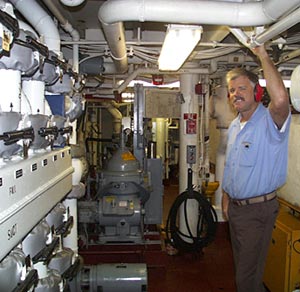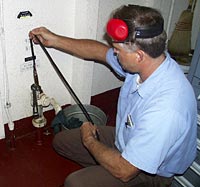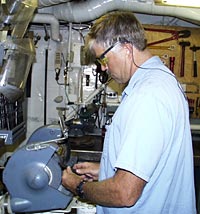|
|
Interviews: Second Assistant Engineer Steve St. Martin
What are you most proud of in life? Steve: I’m most proud of my family. I have two grown sons. Greg is an officer in the Navy working for NATO in Italy. Kevin is 22 and will be graduating from Purdue University in December. He’s going to be a mechanical engineer. The consequence of my job though is I’m going to miss his graduation by one day. As part of my job I’ve missed a lot of my kids growing up. It’s something you can never make up for and is a definite down side to doing what I do. Both my parents are still alive and I would like to spend more time with them, but unfortunately I can’t. Question: What got you started in this job? Steve: I was born in San Diego and when we were boys, my friends and I would go snorkeling and surfing at La Jolla. Sometimes when the surf was low, we would sneak onto Scripps property and watch the scientists working with the aquarium, outside labs and on the pier. The security guards would chase us off the pier, but I knew when I grew up I wanted to work for Scripps. Once I was out of high school, I worked during the day and took college classes at night. Then I had to worry about Vietnam. I joined the Naval Reserve and ended up as a Navy SCUBA diver on a submarine doing special operations. We were spying on North Vietnam, taking pictures of the shipping routes. When I started back in school in the early 1970s I worked as a carpenter. My mom called me and she had found out about jobs working for Scripps on the FLIP. Question: FLIP is the research vessel that flips to provide a steady platform for the scientists, what was that experience like? Steve: FLIP is one of a kind and I spent 10 years on it, so I know it intimately. It’s 365 feet long and made mostly of ballast tanks. The vessel is towed out to sea and the ballast tanks are flooded. It flips 90 degrees and then sinks. When it was first built and they were testing it people would call the coast guard saying they saw a sinking ship, cause that’s what it looks like. You can imagine all the engines, beds, toilets and galley console and everything swivel inside the vessel. When it’s flipped, it has 300 feet underwater and 65 feet above water that’s habitable. Scientists love it because it oscillates only one-tenth of the wave height. It’s impossible to get seasick because it is like being on land in the middle of the ocean. Question: Have you ever seen anything that’s changed your perspective? Steve: If you ever have the chance to go down to Antarctica, you’ll come away believing the possibility for life on other planets. The environment down there is so harsh and yet animals of all kinds are living in Antarctica. There are many different kinds of birds - albatross, penguins and gulls to name a few - whales and seals. The only problem is getting there, you have to cross the Roaring 40s and the Ferocious 50s those are the degree latitudes where the weather is the worst. On the Melville, the bridge is about 55 feet high and we would ride swells that looked like mountains. When we were in the trough of the wave we could look up from the bridge and see the crest above us.
What has been an exciting moment in your career? Steve: One of the most exciting times was when I got my third engineers license. It’s a five-part, multiple choice test and people sometimes take up to a day and a half to finish it. I did it in one morning. I had studied really hard on the Melville for six months, three to four hours a day. During that time I traveled to New Zealand, Australia, Antarctica, Eastern Island and Chile. The only time I had off was in port and that would last from anywhere from a couple days to a week. You could say I worked my way up through the “deck plates” that’s a figure of speech for engineers who work their way up to ship’s officers without going to school. The deck plates are the removable walkways on the floor of the engine room. I did it all on my own studying books while I was out at sea. It was hard, but well worth it. I’ve accomplished my life’s goal. Question: You’re five years from retirement, what will you do then? Steve: I would like to pursue my hobby of photography or start a new business such as marine surveying. That’s like a home inspector, but for boats and private yachts. I would find what’s wrong and make recommendations for fixing things that are requirements for Coast Guard approval. I’ve been married 10 years to a loving and supportive wife. I’m hoping we will have more time together. It’s hard to find a partner with this job, as I’m gone so often. Anne Marie runs her own massage therapy business. She’s had some of her clients for 15 years and they are receptive to her taking time off to meet me at port or go on vacation when I’m at home. |
||||||
Mailing List | Feedback | Glossary | For Teachers | About Us | Contact
© 2010 Dive and Discover™. Dive and Discover™ is a registered trademark of
Woods
Hole Oceanographic Institution

 Steve St. Martin spends most of his time in the engine room. Some of his primary duties include monitoring fuel levels and the ship’s fresh water production.
Steve St. Martin spends most of his time in the engine room. Some of his primary duties include monitoring fuel levels and the ship’s fresh water production.
